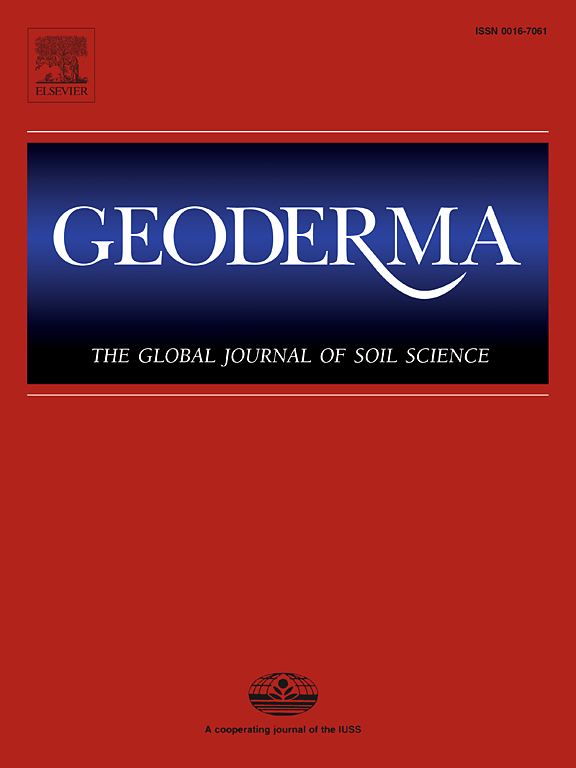Reactive oxygen species generation in earthworm burrows and their impact in drilosphere organic carbon mineralization
IF 5.6
1区 农林科学
Q1 SOIL SCIENCE
引用次数: 0
Abstract
The drilosphere is a hotspot of carbon cycling in terrestrial ecosystems, yet the soil organic carbon (SOC) mineralization within this zone associated with reactive oxygen species (ROS) remains underexplored. Herein, we investigated the spatiotemporal variations of ROS in the drilosphere and evaluated their contributions to SOC mineralization. Fluorescence imaging revealed concentrated ROS hotspots within approximately 2.8 mm of soil surrounding earthworm (Metaphire guillelmi) burrows. Spatially, hydroxyl radicals (•OH) and hydrogen peroxide (H2O2) contents in drilosphere soils were 2218.65 nmol kg−1 and 309.03 μmol kg−1, respectively, significantly higher than those in the background soil (883.92 nmol kg−1 and 138.09 μmol kg−1, p < 0.01). Temporally, •OH and H2O2 contents increased in drilosphere during the first 14 days of incubation, but declined following the removal of earthworms. In contrast, ROS levels in background soils remained stable throughout the incubation period. Correlation analysis revealed that earthworm activity significantly influenced ROS dynamics by altering microbial diversity, soil pH, dissolved organic carbon, and the Fe(II)/Fe(III) cycle (r = 0.60–0.90, p < 0.05). Among the ROS, •OH was an important contributor to SOC mineralization. Inhibiting •OH production decreased CO2 emissions by 34.9 % and laccase activity by 21.6 %. The addition of exogenous •OH increased SOC mineralization rate from 25.76 to 50.36 μg C g−1 soil d-1 and laccase activity from 2.46 to 9.50 U g−1, indicating that •OH stimulates CO2 emissions by increasing enzyme activity. This study identifies earthworm burrows as hotspots for ROS production and provides detailed insights into their ecological role in SOC cycling.

蚯蚓洞穴中活性氧的生成及其对地层有机碳矿化的影响
地圈是陆地生态系统碳循环的热点区域,但该区域内与活性氧(ROS)相关的土壤有机碳(SOC)矿化仍未得到充分探索。在此,我们研究了地圈中 ROS 的时空变化,并评估了它们对 SOC 矿化的贡献。荧光成像显示,ROS热点集中在蚯蚓(Metaphire guillelmi)洞穴周围约2.8毫米的土壤中。从空间上看,钻孔土壤中羟基自由基(-OH)和过氧化氢(H2O2)的含量分别为 2218.65 nmol kg-1 和 309.03 μmol kg-1,明显高于背景土壤中的含量(883.92 nmol kg-1 和 138.09 μmol kg-1,p <0.01)。从时间上看,-OH 和 H2O2 的含量在培养的前 14 天有所增加,但在移除蚯蚓后有所下降。相比之下,背景土壤中的 ROS 含量在整个培养期间保持稳定。相关分析表明,蚯蚓活动通过改变微生物多样性、土壤 pH 值、溶解有机碳和铁(II)/铁(III)循环(r = 0.60-0.90,p <0.05)而显著影响 ROS 动态。在 ROS 中,-OH 是 SOC 矿化的重要因素。抑制-OH的产生可使二氧化碳排放量减少34.9%,漆酶活性降低21.6%。添加外源-OH可使SOC矿化率从25.76 μg C g-1 soil d-1提高到50.36 μg C g-1 soil d-1,漆酶活性从2.46 U g-1提高到9.50 U g-1,这表明-OH可通过提高酶活性刺激CO2排放。这项研究确定了蚯蚓洞穴是产生 ROS 的热点,并详细揭示了它们在 SOC 循环中的生态作用。
本文章由计算机程序翻译,如有差异,请以英文原文为准。
求助全文
约1分钟内获得全文
求助全文
来源期刊

Geoderma
农林科学-土壤科学
CiteScore
11.80
自引率
6.60%
发文量
597
审稿时长
58 days
期刊介绍:
Geoderma - the global journal of soil science - welcomes authors, readers and soil research from all parts of the world, encourages worldwide soil studies, and embraces all aspects of soil science and its associated pedagogy. The journal particularly welcomes interdisciplinary work focusing on dynamic soil processes and functions across space and time.
 求助内容:
求助内容: 应助结果提醒方式:
应助结果提醒方式:


